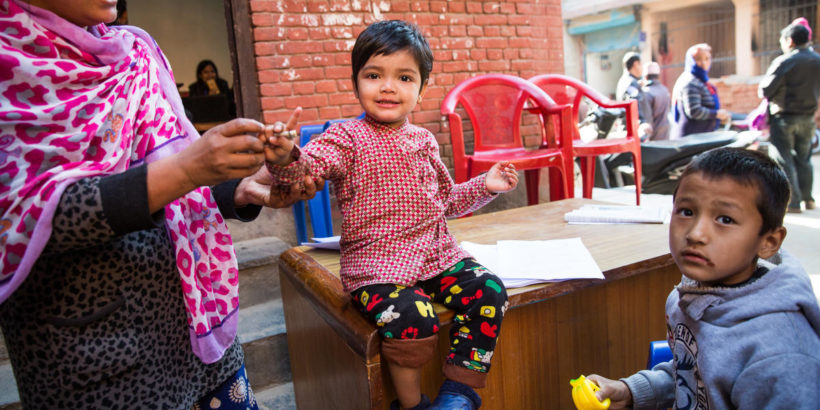For the past two years, we have been part of the typhoid conjugate vaccine (TCV) efficacy study being conducted by Oxford University Clinical Research Unit, Patan Academy of Health Sciences in Nepal. Our team is running a participant and observer blinded, individually randomized controlled study to assess the protective impact of the TCV. We have enrolled and vaccinated more than 20,000 children with either the TCV or meningococcal vaccine (as the control). We have conducted hundreds of follow-up visits and come to know the children and the families involved in the study. The data that we gather in Nepal will tell us how well TCV prevents blood–culture confirmed cases of typhoid.
Although final results will not be available for some time, earlier this year our team identified enough typhoid cases to conduct an interim analysis on the data gathered to date. After thorough analysis, we determined that TCV prevented 81.6 percent of typhoid cases in the study population in Nepal—indicating that 8 out of 10 children vaccinated with TCV have been protected against typhoid. For us living and working in a typhoid-endemic country, this is a major step forward in the fight against typhoid. Globally, this is a major step for all countries weighing the possibility of introducing TCV into routine immunization programs.
Nepal has one of the highest typhoid burdens in the world. This means that our families, neighbors, and colleagues are all at increased risk for contracting typhoid through contaminated food or water. Typhoid takes an economic, mental, and financial toll on our communities and country. For an ill child, typhoid means missed days from school and time spent away from friends. For caregivers, typhoid means staying home to care for the child, missing days of work, and potentially losing wages. Too many children become ill with a preventable disease and may ultimately need care at a clinic or hospital.
With increasing concerns about drug resistance, especially in Nepal, there is worry that antibiotics may not be available to treat a typhoid infection, and when they are available, the cost of treatment will come at a premium. Now, with the data from our interim analysis, we know that TCV can offer substantial protection against typhoid in a country such as Nepal.
This is one of the first studies of this vaccine in a typhoid-endemic setting, and the ability to protect 8 out of 10 children is a major milestone in the fight against typhoid. This new data should reassure decision-makers that this TCV is an effective prevention tool. The opportunity to protect children from typhoid is a chance to provide defense against a highly prevalent disease that has the potential to be fatal if not treated appropriately and on time. For us, this is exciting as part of the research team working on the study, but also, personally, to know that children and families in communities like ours may soon be protected.
Our study is not over yet; there will be more data gathered and more analysis done in the next several years. But in the meantime, these new data are an incredibly encouraging proof point that the TCV has the potential to protect against typhoid and save lives. Our work is not done yet, but we are thrilled to share this milestone as we move forward with our work to take on typhoid.
Please find the full journal article available here.
Photo courtesy of ©Gates Archive/Samantha Reinders



